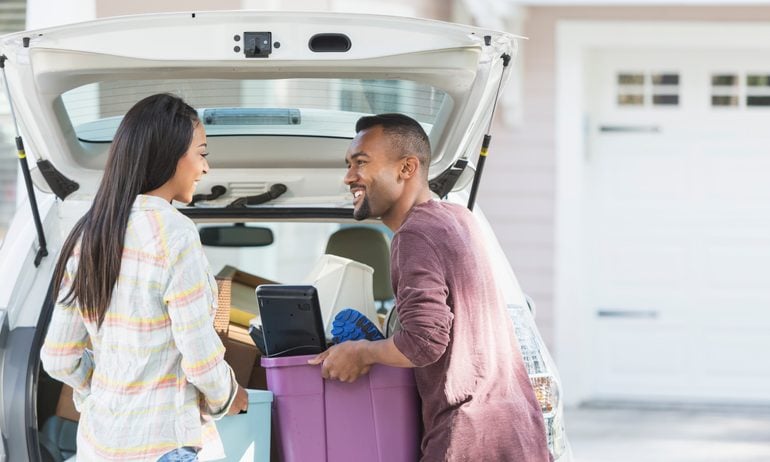Temporary Car Insurance: Five Ways to Get Short-Term Coverage
If you need temporary car insurance, you have a few options to stay insured without breaking the bank.

Many, or all, of the products featured on this page are from our advertising partners who compensate us when you take certain actions on our website or click to take an action on their website. However, this does not influence our evaluations. Our opinions are our own. Here is a list of our partners and here's how we make money.
Insurance companies typically don’t offer “temporary car insurance” policies. Most require six- or 12-month commitments, though you can usually cancel early.
If you need short-term coverage, buy a normal policy and cancel early, or get non-owner car insurance.
If you’re borrowing someone else’s car with permission, you’re likely already covered by their insurance.
It may be tempting to forgo car insurance for a car you’ll only drive for a couple days or months. But if you get into an accident without insurance, you may find yourself in legal and financial turmoil. That’s why you should make sure you’re covered by insurance any time you get behind the wheel of another vehicle — no matter the situation or length of time. Sometimes, that means having to get temporary car insurance.
But most insurance companies don’t sell policies for periods of less than six months. So, what can you do?
See what you could save on car insurance
Easily compare personalized rates to see how much switching car insurance could save you.
In this article, we’ll explore five ways to meet short-term car insurance needs:
Solution | Best if you... |
|---|---|
Occasionally drive someone else’s car with permission. | |
Regularly drive someone else’s car. | |
Own a car but drive it only part of the year, or if you want to resell a car you just bought. | |
Regularly borrow or rent cars and want your own insurance, or if you need to satisfy the terms of an SR-22 insurance form. | |
Don’t own a car but rent one occasionally. |
Rely on the car owner’s insurance
If you’re using someone else’s car with their permission and you’re licensed, you’re likely covered under the car owner’s insurance policy. You just can’t drive it regularly without being listed as a driver on their policy. You also can’t use it for business purposes. To be sure you’re covered, ask the owner to check with their insurance company before you borrow their ride.
Best for:
People who occasionally drive someone else’s car with permission.
Potential drawback
You may be financially responsible for injuries or property damage you cause if those expenses are higher than the car owner's policy limits.
Get on someone else’s policy
When you buy a standard car insurance policy, insurers will generally ask you to add anyone who lives with you or frequently borrows your car to your policy. So, for example, if you’re a nanny and regularly use your client’s car to run errands or if you don’t have car insurance but your roommate does, you may already be listed as a driver on their policy.
But don’t assume you’re on someone else’s policy just because you live with them or borrow their car a lot. An insurer can deny coverage or cancel a policy if it finds out about unreported regular drivers. Ask the owner of the car you’ve been driving to confirm with their insurer that you’re on the policy before taking their car for another spin.
Best for:
People who regularly drive someone else’s car.
Potential drawback
Depending on your driving record and other factors, being added to another person's policy could increase their auto insurance premium. You also could be financially vulnerable if their policy has low coverage limits.
Buy a standard policy and cancel it early
Most car insurance policies last six or 12 months, and you typically pay monthly or all at once. But just because your insurer asks you to commit to a long-term policy doesn’t mean you can’t ditch it early. Generally, you’re allowed to cancel a policy at any time, and you'll be refunded money you paid in advance. So if you paid for a six-month policy upfront and you cancel your policy after two months, you should receive a refund for the remaining four months. Just watch out for cancellation fees that some insurers charge.
Best for:
Drivers who own a car but drive it only part of the year.
Potential drawback
Owning an uninsured car that’s registered can make you look risky to future insurers, resulting in higher premiums next time you get a policy.
You can avoid an insurance gap by reducing coverage to your state’s minimum requirements during stretches when you don’t drive. You can also get comprehensive-only insurance, sometimes called “parked car insurance.” This pays for any nondriving-related mishaps that may happen to your car while it sits in storage.
Buy non-owner car insurance
As the name suggests, non-owner car insurance is meant for people who don’t own their own car but frequently borrow or rent cars. It typically includes your state’s minimum insurance requirements, though you may be able to increase coverage limits. Non-owner car insurance can also pay out if the car you're driving is already insured but doesn’t have enough coverage to pay for all injuries and property damage you cause after an accident.
Non-owner car insurance can also provide temporary insurance for drivers who don’t own a car but need to file an SR-22 insurance form with their state.
Best for:
People who regularly borrow or rent cars and want their own insurance, and people who have an SR-22 requirement.
Potential drawback
It might not be worth the extra cost if you drive only once or twice a year. In that case, you might be better off relying on the vehicle owner's insurance or rental car insurance instead.
Buy rental car insurance
Most personal car insurance policies also cover cars you rent for personal reasons. But what if you don’t have your own car insurance and need to rent a car? The good news is that most rental car companies and car-sharing services, like Turo, automatically include at least enough insurance to drive legally. The bad news is that might not be enough, especially if you wreck it or it gets stolen.
You can usually buy additional coverage through the rental company or car sharing service, like supplemental liability protection or a collision damage waiver, which pays to replace or repair the car if it’s stolen or damaged during the rental period. Another option is to buy a standalone rental car insurance policy, which you may be able to get on a day-by-day basis.
Best for:
People who don’t own a car but rent one occasionally.
Potential drawback
The minimum insurance limits automatically included with your rental likely won’t be enough to cover a bad crash, and buying additional car insurance from a rental car company or ridesharing service can be costly.
» MORE: Rental car insurance explained
Speak with an agent
Still not sure which temporary car insurance option is best? Reach out to an independent insurance agent to talk through your situation. They can offer advice tailored to the laws and provide coverage alternatives in your state.
Nerdy Perspective





